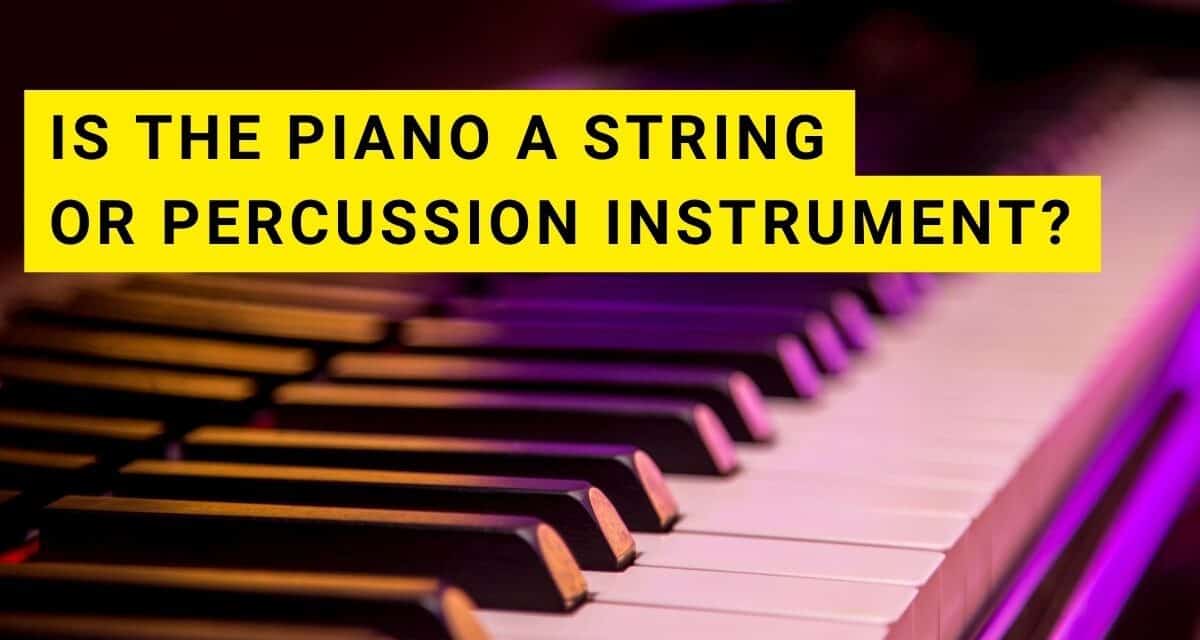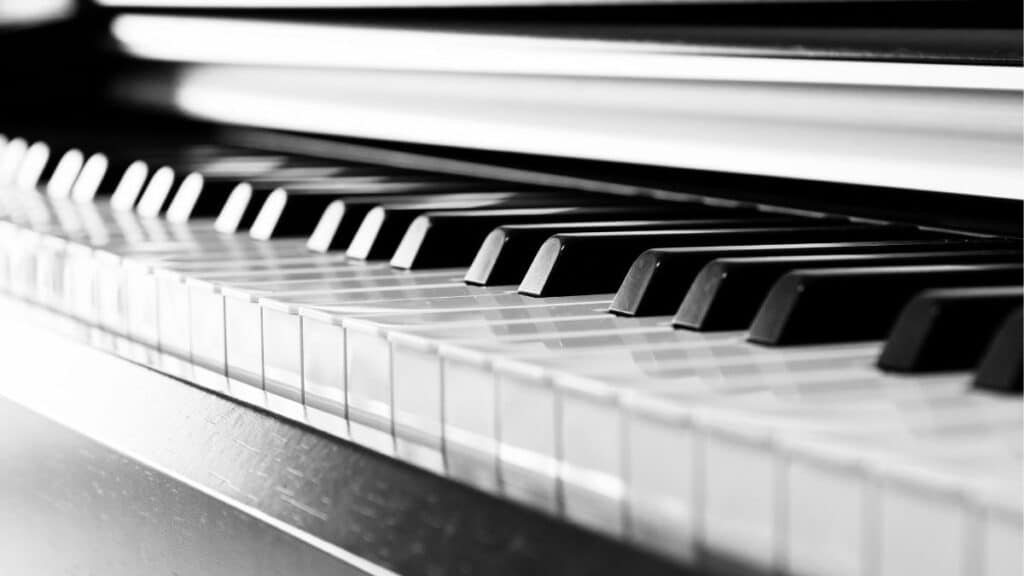Here’s a conundrum that’s as intriguing as the music itself: is the piano a percussion or string instrument?
Despite the smooth surface of its keys and the gentle clink of each press, beneath the lid lies a complex mechanical world. It’s a complex mixture of strings, hammers, and dampers working in unison to create the iconic sound of a piano.
Many musical instruments are easy to classify but the piano belongs to its own unique category.
It may look simple on the outside, but the inside of an acoustic piano is anything but that.
In this article, we delve into the classification of the piano and explore this musical instrument in detail.
Understanding the Piano’s Construction
It’s said that you can’t judge a book by its cover.
This saying rings true when we look upon the piano, an instrument whose complexity is hidden beneath a sophisticated, polished exterior.
It is an instrument of dichotomy; the pianist’s touch may be gentle, yet the sound produced is robust and full of life.
At the heart of the piano’s construction are two key components: the piano strings and the hammers.
Each piano, be it a grand or an upright, is home to hundreds of tightly wound strings made of steel. The number of strings for each key varies, but they all serve the same purpose: to vibrate at specific frequencies and produce a desired pitch when struck.
The hammers, on the other hand, are the mechanisms that strike the strings when a key is pressed. They’re typically made of wooden cores covered in felt and arranged in a way that corresponds directly to the keyboard layout.
When you press a key, you’re effectively setting a rapid sequence of mechanical actions into motion that results in the hammer hitting a string. These hammers add the ‘percussive’ to the piano’s performance, igniting a debate that has echoed through the concert halls and music conservatories for centuries: Is the piano a string or a percussion instrument?
Note: Not to be confused with keyboard instruments. These popular instruments produce sounds using electronics instead of using fixed strings.
Is Piano a String Instrument?
When discussing whether the piano falls under the category of string instruments, we must first take a step back to understand what defines this category. Stringed instruments, also known as chordophones, produce sound through the vibration of strings.
This is typically achieved by plucking, striking, or bowing the strings. Undeniably, the piano shares a clear alignment with this group.
Chordophones – similar to a harp or lyre, have strings stretched between two points.
Dive into the soul of a piano, and you’ll find hundreds of tautly stretched strings, each meticulously tuned to resonate at the perfect pitch. The frequency of each string’s vibration is controlled by its tension, mass, and length. When the keys are struck, hammers inside the piano engage these strings, causing them to vibrate and emit the corresponding notes. Hence, if one focuses solely on the source of the sound – the vibrating strings – the piano indeed qualifies as a stringed instrument.
Is the Piano a Percussion Instrument?
Yet, the tale doesn’t end there. A significant aspect of the piano that sets it apart from most string instruments is its action mechanism: the felt-covered hammer. This brings us to the possibility of being classified as a percussion instrument.
When classifying musical instruments, percussion instruments are a group characterized by sound production through striking, shaking, or scraping.
In a piano, the hammers strike the strings when a pianist presses a key, giving rise to a forceful, percussive action. The energy imparted by the hammers is transferred to the strings, causing them to vibrate and produce sound. Hence, if we focus on the mechanism of sound production – the act of striking – the piano bears a strong resemblance to percussion instruments.
Interestingly, percussion instruments are further classified into pitched (like timpani, which can play different notes) and unpitched (like bass drums, which don’t have a definite pitch). Within this classification, a piano would certainly fall into the ‘pitched percussion’ category. Thus, seen from the lens of the action mechanism, the piano could indeed be classified as a percussion instrument.
This dichotomy – a string instrument based on sound source, a percussion instrument based on action mechanism – places the piano in a unique category that straddles both these worlds. It’s this ability to embody the characteristics of two distinct types of instruments that adds to the charm and intrigue of the piano.
The Hybrid Nature of the Piano
The piano, with its unique characteristics, effectively straddles the divide between string and percussion instruments.
This dual identity stems from its distinct mechanism of sound production, which embodies elements of both categories. On one hand, the strings, integral to create sound, qualify it as a string instrument. On the other, the striking mechanism where the hammers hit the strings gives it a percussive nature.
The fusion of these two characteristics results in an instrument of unmatched versatility. A piano can generate a wide array of sounds, from gentle, mellow tones akin to a string instrument to the forceful, rhythmic strikes characteristic of percussion instruments. It’s this hybrid nature that gives the piano its unique expressiveness, enabling it to produce a diverse spectrum of musical notes and rhythms. This sets the piano apart from most other instruments, placing it in a category of its own—a hybrid of string and percussion.
How is the Piano Classified in an Orchestra?
In the context of an orchestra, the piano’s classification is subject to interpretation. Traditionally, orchestras are grouped into families of instruments—strings, woodwinds, brass, and percussion—based on their sound production and physical characteristics.
For example, a woodwind instrument is made of cylindrical pipes and a wind instrument uses the vibration of air to create music.
While pianos have strings, they’re typically not included in the string section of an orchestra. This is because the sound of a piano is produced through a percussive action, rather than the bowing or plucking associated with other string instruments such as violins or cellos.
Interestingly, the piano often finds its place in the percussion section of an orchestra. The reason is its action mechanism—the hammers striking the strings—which aligns it with other instruments in the percussion family. Yet, its capacity to play melodies and harmonies sets it apart from many other percussion instruments, which are often restricted to rhythmic roles.
However, it’s important to note that the piano’s role within an orchestra isn’t limited to one specific section. It often transcends these boundaries, assuming a variety of roles based on the composition being performed. In some pieces, it may take on a solo role, while in others, it may blend with the orchestra, enhancing the overall harmony. This flexible positioning within the orchestra only underscores the piano’s unique hybrid nature, further blurring the lines between the string and percussion classifications.
Conclusion: Piano is Both a Percussion and Stringed Instrument
Is the piano a string instrument or a percussion instrument? As we have discovered through our exploration, the answer is not as straightforward as it might initially appear. The piano, with its unique construction and method of sound production, exists in a realm that straddles the boundaries of these two classifications.
While its strings would seemingly place it in the company of violins, cellos, and harps, its action mechanism, where hammers strike the strings, aligns it closer to the realm of drums, xylophones, and glockenspiels. The piano is a hybrid, bearing the characteristics of both string and percussion families, contributing to its unparalleled versatility in the world of music.
In an orchestral context, the piano often finds itself within the percussion section due to its hammer-action mechanism. However, its role is flexible, sometimes leading with harmonious melodies, at other times punctuating the rhythm, showing that its identity transcends the conventional categorizations.
The piano, therefore, is a testament to the diversity and adaptability of musical instruments. Its categorization as a string or percussion instrument depends largely on perspective, and it beautifully embodies elements of both. In the end, whether you view the piano as a string instrument, a percussion instrument, or a hybrid, its expressive power and musical richness are undeniable.







